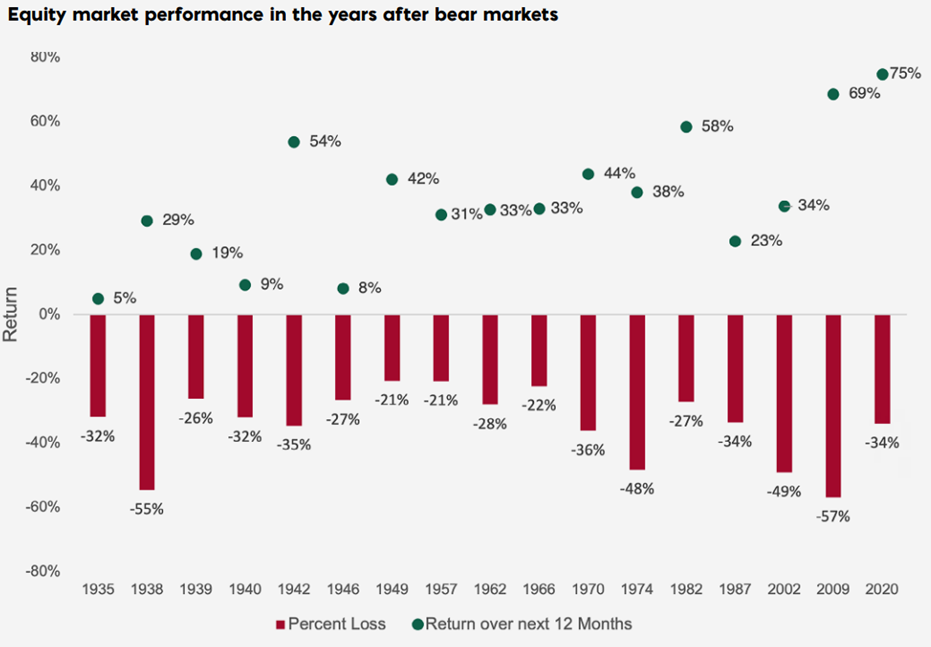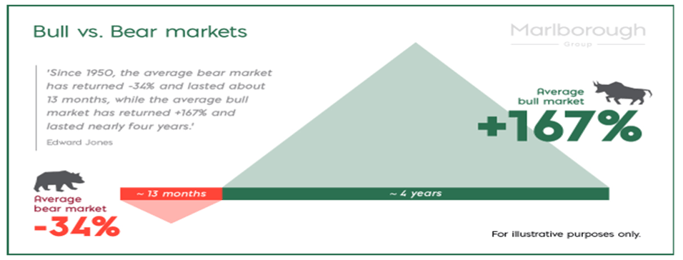Bull vs Bear Markets
In 2022 we experienced one of the most challenging years for investors since the Global Financial Crisis. Investors and consumers have been in a fistfight with inflation. We have endured runaway costs in everything from energy and food prices to holidays and building materials. As a reminder, inflation reached a four-decade high in 2022. Moreover, bond markets witnessed one of their worst years since records began. Consequently, many different asset classes fell into ‘bear market’ territory due to concerns about rising inflation and the impact rising interest rates can have on company profits. So, what is the difference between a ‘bull’ and a ‘bear’ market and how can they impact your investments?
Bull and bear markets are terms used to describe the overall trend of the stock market. A bull market is characterised by a period of rising stock prices, while a bear market is characterised by a period of falling stock prices. If stock markets fall by over 20%, they are considered to be in bear market territory.
One of the key advantages of a bull market is that it provides a positive environment for investors to make profitable investments. During a bull market, companies tend to have higher earnings and stock prices generally increase, providing opportunities for investors to make profits. Additionally, bull markets are often accompanied by a strong economy, which can lead to more job opportunities and higher wages.
On the other hand, bear markets can be challenging for investors, as stock prices tend to decline, leading to potential losses. However, bear markets also present opportunities for long-term investors to buy stocks at discounted prices. Additionally, bear markets are often followed by bull markets, providing opportunities for investors who were able to resist the urge to sell at the wrong time.
The chart below shows the performance of the S&P 500 in the 12 months following a bear market.

Source: Marlborough 24/01/2023
One of the key advantages of long-term investing is the ability to ride out market fluctuations. Many investors are tempted to try and time the market by buying and selling stocks based on short-term market trends. However, this strategy is often unsuccessful and can lead to significant losses. On the other hand, long-term investors who can resist the urge to try and time the market and instead focus on building a diversified portfolio over the long-term are historically, likely to be more successful.
Another advantage of long-term investing is the power of compounding. Compounding is the process of earning interest on interest, which can lead to significant growth over time. For example, if an investor were to invest £10,000 at an annual return of 5% over a period of 30 years, the investment would grow to over £43,000. The longer the investment period, the greater the potential for compounding to work in an investor's favour.
Additionally, long-term investing allows investors to take advantage of pound-cost averaging. This is a strategy in which an investor invests a fixed amount of money at regular intervals, regardless of the market conditions. By investing a fixed amount of money at regular intervals, investors can take advantage of lower prices during bear markets. It can work to your disadvantage where markets are rising, and the value of your contributions could be lower than if you had invested the full amount. It is important to obtain professional advice.

Source: Marlborough 24/01/2023
| Your capital is at risk and the value of investments, as well as the income from them, can go down as well as up and you may not recover the amount of your original investment. Past performance is not a reliable indicator of future results. Investments should be considered over the longer term and should fit in with your overall attitude to risk and financial circumstances. |
In conclusion, bull and bear markets are a normal part of the stock market cycle, and it is important for investors to understand the characteristics of both in order to make informed investment decisions. Long-term investing provides many advantages over short-term investing, including the ability to ride out market fluctuations, the power of compounding, and the ability to take advantage of pound-cost averaging. Investors who can resist the urge to try and time the market and instead focus on building a diversified portfolio over the long term are more likely to be successful.
We expect 2023 to be a year in which many asset classes bounce back from their 2022 lows. However, the opportunities will vary across different geographical regions and asset classes. As a result, investors may benefit from holding multi-asset portfolios that can capture opportunities, while also providing diversified exposure to help buffer the impact of less favourable market moves. As the focus shifts from inflation to a recession, it is important not to allow a challenging economic backdrop to cloud your judgment. The investment opportunities thrown up by the events of 2022 do not happen often and are not to be missed.
It is important to keep in mind that past performance does not guarantee future results and all investments carry risks. It is always wise to consult a financial advisor before making any investment decisions.
With thanks to Nathan Sweeney, Marlborough Investment Management, January 2023
